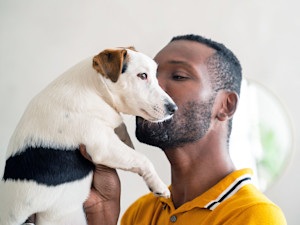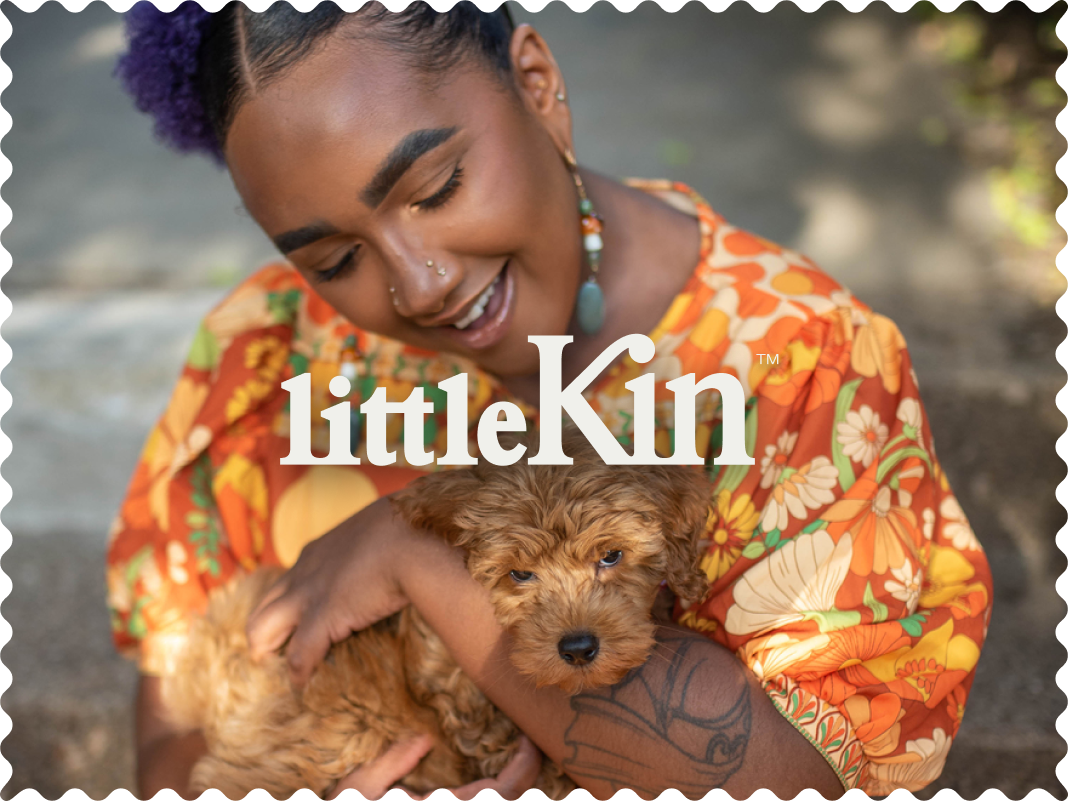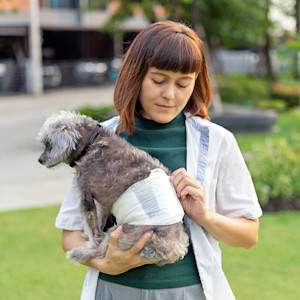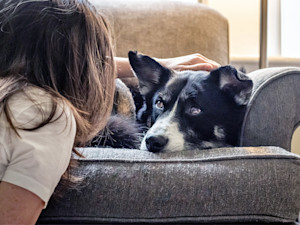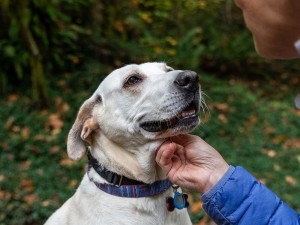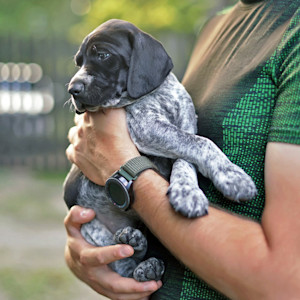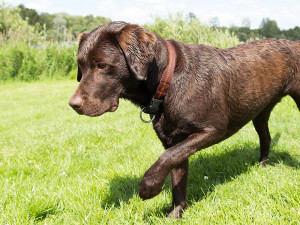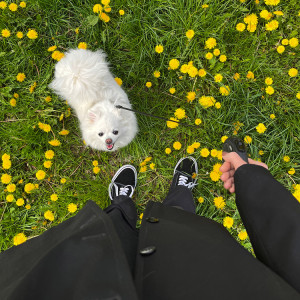How Can You Tell if Your Dog Is in Heat?
In This Article:
What Does It Mean For a Dog to Be In Heat? When Do Dogs Go Into Heat? Behavioral Signs My Dog Is In Heat Physical Signs My Dog Is In Heat
If your female dog isn’t spayed, you may be wondering or worrying about her going into heat. Whether breeding is your goal, you’ll need to know how to tell when she’s in heat to make sure you take the appropriate actions to care for her.
What does it mean for a dog to be in heat?
Being “in heat” refers to a specific part of a female dog’s reproductive cycle. Unspayed female dogs will experience an estrous cycle in which a change in hormones makes it so that females are receptive to breeding with a male and becoming pregnant. With this shakeup in hormones comes behavioral and physical changes that let us know what’s going on.
The estrous cycle consists of four phases, each with its own set of signs.
How much do you spend on your pet per year?
Proestrus: This is when the first signs of heat will appear. Though your dog may be more interested in males at this time, she won’t actually allow breeding. Proestrus lasts around seven to 10 days.
Estrus: During this phase, females allow males to mount and breed and are capable of becoming pregnant. This lasts for five to 10 days.
Diestrus: This is the recovery period where either the female is pregnant, or she’s allowing her reproductive tract to recover from the hormonal changes of estrus and proestrus.
Anestrus: Anestrus is the true period of downtime when nothing reproductive is going on.
When do dogs go into heat?
When a dog goes into heat depends on their breed and size. Smaller dogs tend to start their cycles a bit earlier and have them more often than their larger counterparts.
A dog’s first heat typically starts around four months old for smaller pups and between 18 and 24 months for giant breeds. Generally speaking, six months old is a good round number to be on the lookout for a dog’s first heat cycle.
How often do dogs go into heat?
Unspayed dogs continue to have heat cycles roughly twice a year, in the spring and fall. Some smaller breeds will try to overachieve and have three cycles per year, while large or giant breeds may go in the other direction and only cycle once every 12 months.
There is a common misconception that you should allow your dog to have one heat cycle before spaying her. All this does is increased your chances of having an unplanned pregnancy. Instead, talk to your vet about the best time to spay your dog; smaller breeds can be spayed before they ever go into heat, while larger breeds may want to wait a little longer to allow their body to fully mature to prevent certain types of cancers and developmental issues.
Behavioral signs my dog is in heat
Now that you’re on the lookout for your puppy’s first heat or your dogs’ biannual cycle, here’s what you’re looking for.
Interest in male dogs: Some dogs love every dog, no matter the season, but a dog verging on estrus will show an increased interest in males specifically for a reason other than playing.
Licking genitals: The swollen vulva and vaginal discharge that comes with proestrus may be very distracting to your pup. She may spend a lot of her time licking at her genitals to keep them clean.
Changes in behavior: Hormones can do crazy things to a dog’s brain, making her a bit more aggressive towards other dogs and people, easily agitated, or even more clingy.
Restlessness: Females in heat may pace the room and pant, looking for a way out or trying to burn off nervous energy.
Humping: Some females will hump objects or things while in heat. This humping behavior may be seen for a number of other reasons as well.
Remember that every dog is different, so they may only show some of these signs or all of them.
Physical signs my dog is in heat
If the behavioral changes don’t clue you in, there are some backup physical signs to look for.
Swollen vulva: The outer portion of your dog’s genitals may swell. So, if it wasn’t noticeable before, it will be while they’re in heat.
Swollen nipples: The nipples along your dog’s belly may be more noticeable as well.
Bloody discharge: During proestrus, a dog may have a bloody discharge for about a week. Then, as they become more receptive to a male, that discharge may thin and become more pink or yellowish in color.
Frequent urination: Expect to let your pup outside more frequently during the two to three weeks your dog is in heat. Also, be ready for male dogs to be very interested in that urine as it contains a lot of pheromones.
Caring for your dog in heat
Dogs have been going into estrous for thousands of years with little assistance from us. So, your dog will likely take care of things on her own. But that doesn’t mean you don’t need to pay a little extra attention to your pup while she’s in heat.
Start by providing her with a quiet place where she feels safe and comfortable. Make it easy to clean as her vaginal discharge can be very messy. You may want to consider a doggie diaper to keep the mess more contained.
If you don’t want your dog bred, you’ll need to be extra vigilant to keep her inside and away from male dogs. Exercise her as normal, but avoid heavy dog traffic areas where she will be the center of attention with any males nearby. Always supervise her when she’s outside, even in a fenced yard, as both your dog and any neighboring males will go to extremes to get together.
When to seek expert help
Estrous is completely natural and typically doesn’t require your intervention, but you may need to get your veterinarian involved if problems arise, such as the following:
An infection: Red, reddish brown, pink or yellowish discharge are the norm. Off colors, such as brown, green, or greenish yellow may mean an infection, especially if it also comes with a foul odor or lasts longer than seven to 10 days.
Aggression: It’s normal for your dog to become a little more anxious or even snappy with other dogs while in heat, but if she’s becoming overly aggressive to the point she’s going to hurt someone, contact your vet.
False pregnancy: The diestrus phase conveniently lasts about the same duration as a pregnancy. During this time a dog is under the influence of the same hormones whether she’s pregnant or not, so her body may become a little confused, thinking she’s pregnant when actually she is not. Dogs experiencing a false pregnancy may get a swollen belly, mother inanimate object, and even lactate. Most of the time a dog’s false pregnancy will end when her hormones change but it sometimes requires veterinary intervention.
Spaying: It’s highly recommended to spay your dog as soon as is deemed appropriate if you don’t plan to ever breed your dog. Sometimes, coming into heat is your reminder to get it done. Though dogs can be spayed when they’re in heat, most veterinarians will recommend waiting until their heat cycle is over to avoid potential extra bleeding.
References
“Dog Estrous Cycles.” Cornell Riney Canine Health Center. https://www.vet.cornell.edu/departments-centers-and-institutes/riney-canine-health-center/canine-health-information/dog-estrous-cyclesopens in new tab.
Royal, Maegan. “Spaying and neutering dogs can help them live longer.” UAB News. 29 May 2019. https://www.uab.edu/news/news-you-can-use/spaying-and-neutering-dogs-can-help-them-live-longeropens in new tab.
Vaughan, Don. “Can Animals in Heat Be Spayed?” Veterinary Practice News. 23 Sep 2021. https://www.veterinarypracticenews.com/can-animals-in-heat-be-spayed/opens in new tab.

